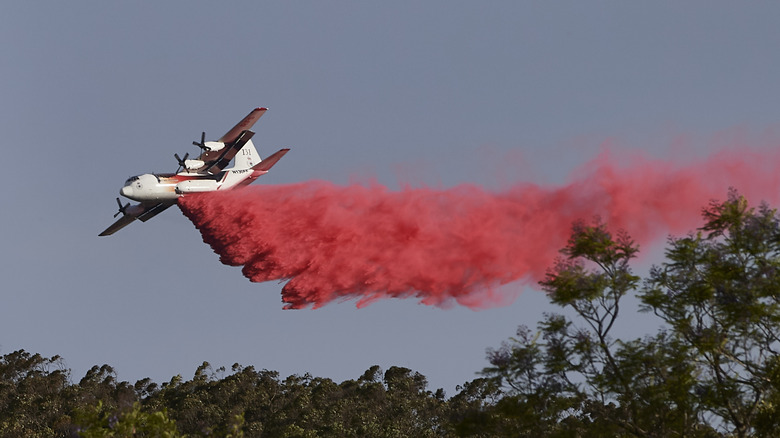What Is That Stuff We Dump On Wildfires From Airplanes??
During wildfire season in the American West (which is coming earlier every year, via USDA), you might see airplanes dumping a powdery red substance onto the flames. This fire retardant, called slurry, is largely a mixture of fertilizer (primarily ammonium phosphate) and water, according to Time magazine. It's red because of added iron oxide — rust — which keeps the mixture visible and shows firefighters what areas have already been sprayed down (per Mental Floss). The slurry is kept from evaporating or blowing off by the inclusion of thickeners, such as guar gum or clay. And though it makes a mess, the red slurry should wash away with water.
The slurry isn't a fire extinguisher — instead, the retardant slows the spread of the fire so that firefighters can control it. "Basically, they're trying to box in the fire," said Janet Upton of the California Department of Forestry and Fire Protection, to Time. But is using this slurry safe?
The slurry may affect plant and animal life
In 2006, 31.3 million gallons of the slurry were used for firefighting, so it had better be. Upton told Time that the slurry isn't environmentally harmful, though firefighters take care to avoid using it near waterways, and pets should be kept from eating the slurry since it contains fertilizer. More recent studies have found that the material can be harmful to aquatic life, according to the San Gabriel Valley Tribune.
And if the slurry is not washed off trees right away, which is possible during a drought, scientists aren't sure if the increased exposure affects plant life. "Having salt sitting on your leaves — that would interfere with the leaf surface," explained Marti Witter, a scientist with the National Park Service, to SGVT. "Salts are not that great."
For humans, the effects of getting doused in the slurry are limited to skin and eye irritation or an allergic reaction, according to a 2007 study by U.S. Forest Service.

